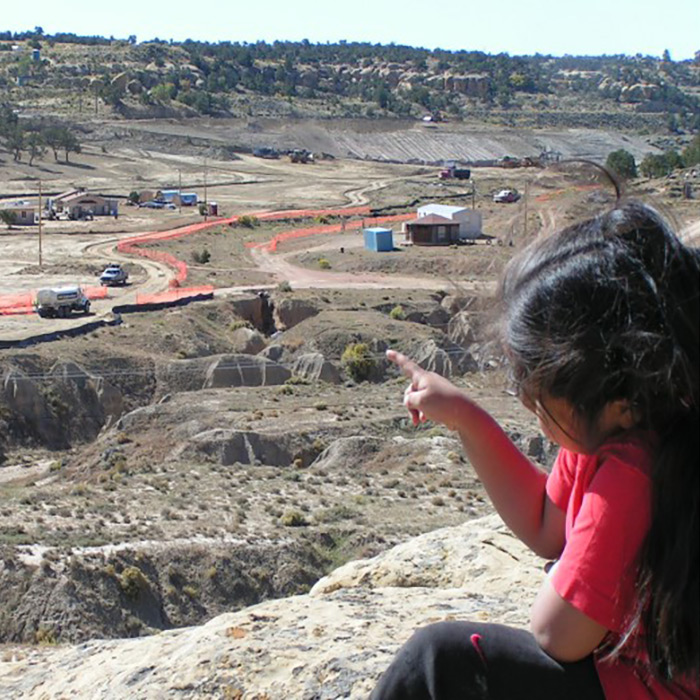Global Environmental Health

Partnering With Indigenous Communities to Improve Tribal Health
August 01, 2023
Expert: Johnnye Lewis, Ph.D., University of New Mexico
Photo: A 4-year-old Navajo boy watches as a foot and a half of soil contaminated by radioactive material is removed from his community in 2009. The gray pile in the upper right is the waste from New Mexico’s Northeast Church Rock Mine, where 3.5 million tons of uranium ore were extracted between 1967 and 1982, when mine operators ceased activity and abandoned the site. The waste pile remains in the community today. (Photo courtesy of Teddy Nez)
In early August, President Biden established the Baaj Nwaavjo I’tah Kukveni – Ancestral Footprints of the Grand Canyon National Monument in Arizona. Encompassing nearly 1 million acres in the greater Grand Canyon region, the monument protects lands sacred to Native American Tribes from new resource extraction, including uranium mining.
In his proclamation, President Biden noted how the history of the area “tells a painful story about the forced removal and dispossession of Tribal Nations and Indigenous peoples.”
That story is still unfolding. Indigenous communities face a variety of environmental health threats, including exposures to toxic chemicals from legacy hardrock mining activity and from solid waste combustion.
In this podcast episode, we speak with Johnnye Lewis, Ph.D., a toxicologist at the University of New Mexico (UNM) and longtime director of its NIEHS-funded Metals Exposure and Toxicity Assessment on Tribal Lands in the Southwest (METALS) Superfund Research Program (SRP) Center. We discuss Lewis’s work with Native American Tribes to understand routes of chemical and heavy metal exposure. She will also share how community engagement can inform culturally appropriate research and messaging while encouraging innovation and broader understanding in the environmental health science field.

Johnnye Lewis, Ph.D., is a toxicologist at UNM with extensive experience in community-engaged research with Tribal Nations. After working with several Indigenous communities to study and address health impacts of Cold War contaminants, Lewis founded UNM’s Community Environmental Health Program in 1996.
In 2017, she became the first director of the UNM METALS SRP Center. From 2015 to 2020, she was director of the Center for Native Environmental Health Equity Research, initially funded by NIEHS and the U.S. Environmental Protection Agency. From 2016 to 2023, she also directed the Navajo Birth Cohort Study Pediatric Cohort in the Environmental influences on Child Health Outcomes (ECHO) Project, funded by the NIH Office of the Director.
As she moves into retirement, Lewis now co-leads the Center for Native Environmental Health Equity Research, with funding from the National Institute of Minority Health and Health Disparities in partnership with NIEHS, as well as the Navajo Birth Cohort Study ECHO Project. Although she is still directing the METALS SRP Center, she is beginning a similar transfer of responsibilities for that center. In her capacity as professor emerita, Lewis is dedicated to ensuring a smooth leadership transition to long-term collaborators who share her goals of community-driven, partnered research.
Lewis completed her Ph.D. in pharmacology at the University of Manitoba and a postdoctoral fellowship at the Lovelace Inhalation Toxicology Research Institute. Before joining UNM, she worked as a consultant in risk assessment for the Department of Energy Waste Isolation Pilot Project and the Moab Uranium Mill Tailings Remedial Action project, with a focus on groundwater. She also led the Canyons Project to evaluate contaminant impacts from Los Alamos National Laboratory on adjacent Tribal lands, and, through a cooperative agreement with the Centers for Disease Control and Prevention, headed an initiative to involve communities in Northern New Mexico in the Los Alamos Dose Reconstruction.


